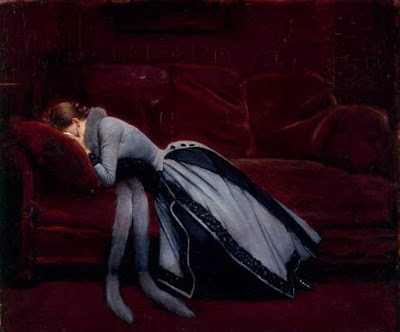Shame: "After the Misdeed", c1885

Isabella reporting,
Although Loretta and I live hundreds of miles apart, we often (very often) talk on the phone, and one of our recent conversations centered on how frequently shamed and fallen women appear in 19thc art and literature.
The reasons for this are, of course, so many and varied that I can't possibly address them all successfully in a mere blog post. (The Foundling Museum in London recently held and exhibition devoted to the myth and reality of The Fallen Woman, and the exhibition's web site still has a number of good links to explore here .) The morality of the time was behind much of it. The perceived "frailty" of women and the need for them to be protected by Good Men, husbands, fathers, and brother, also meant that women were equally susceptible to unfortunate choices, seduction, and ruin at the hands of Bad Men.
In art (if not in life), the women who became fallen were usually young and beautiful, adding a salacious edge to the tragic morality tale. Not surprisingly, the Bad Man - the rake, the bounder, the seducer - rarely merits a painting of his own.
All of which led Loretta and me to this beautifully dramatic painting. (As always, click on the image to enlarge it.) The artist is a Frenchman, Jean Béraud (1849-1935), who was a contemporary and friend of the Impressionists, and best known at the time for his scenes of Belle Epoque Paris. But he also painted his share of genre and morality pictures. His most over-the-top one is St. Mary Magdalene in the House of Simon the Pharisee, which introduces both Jesus Christ and a well-corseted and repentant Mary Magdalen into a group of wealthy 19thc Frenchmen; I particularly like the unimpressed fellow lighting his cigar to the left.
By comparison, After the Misdeed is subdued. The woman's pose, her face buried in shame against the sofa, leave no doubt that she's sinned. Nineteenth century viewers would be certain that the misdeed she'd just committed must be sexual. Her beautifully fashionable clothing could either show that she's a well-bred lady who has wandered - a pampered daughter rejecting a proper suitor for a cad, or an adulterous wife, instantly filled with regret? Or is she a demi-mondaine, a woman who sold her virtue in return for that elegant fur tippet and bustled dress? The lush red velvet sofa could also represent luxurious excess, a symbol of the woman succumbing to passion.
But Loretta and I aren't 19thc gallery-goers. Despite being Nerdy History Girls, we're firmly in the 21stc, and we couldn't resist considering less momentous possibilities for After the Misdeed. Did this distraught lady arrive at a party where the hostess wore the same dress? Did she use the wrong fork at dinner? Did she leave the parlor door open so that the family dog made a mess on that velvet sofa?
What would you guess her misdeed to be?
Above: After the Misdeed by Jean Béraud, c1885-90, National Gallery, London.
Published on January 10, 2016 17:00
No comments have been added yet.



